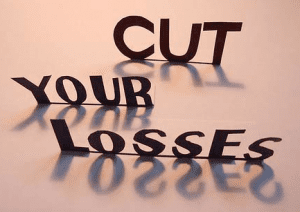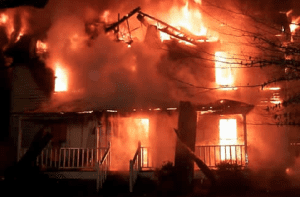 There is a growing body of research revealing that many human’s have an irrational obsession with loss. Or, perhaps more accurately, an irrational obsession with AVOIDING loss. This phenomenon is something I have seen played out in my evaluation of many casualty incidents. Ironically, the human trait to avoid loss is the same trait that can lead to a firefighter casualty. Let’s investigate this irrational human obsession – avoiding loss.
There is a growing body of research revealing that many human’s have an irrational obsession with loss. Or, perhaps more accurately, an irrational obsession with AVOIDING loss. This phenomenon is something I have seen played out in my evaluation of many casualty incidents. Ironically, the human trait to avoid loss is the same trait that can lead to a firefighter casualty. Let’s investigate this irrational human obsession – avoiding loss.
Refusing to cut losses
 In the book Sway: The Irresistible Pull of Irrational Behavior, the authors chronicle the story of a guy who started and built a successful high-tech company and then sold it. The sale reaped him a very large windfall. Despite the advice of his financial adviser, he invested all of his proceeds in the purchase of stock in his new publicly traded company.
In the book Sway: The Irresistible Pull of Irrational Behavior, the authors chronicle the story of a guy who started and built a successful high-tech company and then sold it. The sale reaped him a very large windfall. Despite the advice of his financial adviser, he invested all of his proceeds in the purchase of stock in his new publicly traded company.
The initial stock offering price was $46 per share. Shortly after the stock when public, however, it dropped to $41 per share. The broker suggested the stock be sold. But the investor refused to sell and, instead, advised his broker that when the stock got back to $44 per share, he’s to sell it all. But the stock didn’t go back up to $44 per share. Instead it dropped to $36 per share. The broker again urged his client to sell out. But the investor refused and countered when the stock gets up to $40 per share he’d sell off his remaining shares.
But the stock didn’t go back up. In fact, it continued to fall until it’s value was $.12 per share. That’s twelve cents per share. He lost it all because he didn’t want to cut his losses. Instead, despite all the clues and cues that things were crashing down around him, the investor stayed true to his plan and suffered a catastrophic loss.
The irrational obsession with loss – the emergency scene version
 An incident commander makes a plan of action at an emergency scene. I short amount of time passes by and things are not going well. The commander has three decision choices. First, the commander could tell the crews to discontinue their operations, take a defensive position, and give up on the possibility of accomplishing the mission. Second, the commander could invest more resources by deploying more personnel. Finally, the commander could allow the existing resources to continue on their course without adding any additional personnel to the firefight.
An incident commander makes a plan of action at an emergency scene. I short amount of time passes by and things are not going well. The commander has three decision choices. First, the commander could tell the crews to discontinue their operations, take a defensive position, and give up on the possibility of accomplishing the mission. Second, the commander could invest more resources by deploying more personnel. Finally, the commander could allow the existing resources to continue on their course without adding any additional personnel to the firefight.
When things aren’t going well what’s a commander to do? If the research into irrational obsessions with losses are applied to the emergency incident scene scenario, the commander might wait for personnel to make progress. Then, if the conditions continue to get worse, the commander may once again mentally bargain with him or herself, giving the crew more time to recover and recoup the losses. Then, as conditions continue to deteriorate, the commander stays true to a plan that is not working.
It’s almost as if the commander is in denial that the plan is not working. Thus, the commander stays true to a course of action and, like the investor, the outcome is tragic and the losses are significant.
Chief Gasaway’s Advice
 My advice is founded in expectations. Expectations are both part of the decision making process – expecting outcomes – and situational awareness – being able to make predictions of the future. When commanders assign tasks to operational personnel they should set a time limit for task completion. I call it the “bogey time.” It’s the commander’s best estimation of how much time they are going to allow pass before they change the course of action. I addressed the concept of expectation previously so I won’t rehash it here (CLICK HERE FOR A LINK TO THE POST). Suffice it to say the commander must set a time when the tactics go from offensive/aggressive to defensive/conservative.
My advice is founded in expectations. Expectations are both part of the decision making process – expecting outcomes – and situational awareness – being able to make predictions of the future. When commanders assign tasks to operational personnel they should set a time limit for task completion. I call it the “bogey time.” It’s the commander’s best estimation of how much time they are going to allow pass before they change the course of action. I addressed the concept of expectation previously so I won’t rehash it here (CLICK HERE FOR A LINK TO THE POST). Suffice it to say the commander must set a time when the tactics go from offensive/aggressive to defensive/conservative.
This bogey time is also what helps the commander develop Level 3 Situational Awareness – the ability to accurately predict the future events. As a refresher, for situational awareness to be strong, a responder must develop it on three levels. Level 1 is capturing clues and cues. Level 2 is comprehending the clues and cues into meaning something in the context of the current moment. Level 3 is being able to make accurate predictions of the future.
The challenge comes when the optimistic future prediction is not coming to be the reality of the situation. As the losses mount, its the decisions of the commander that stands to set up or prevent a tragedy.
I think it is very beneficial for a commander to periodically take pause and imagine,mentally, that he or she just arrived and start an original size up and ask “If I just arrived at this incident, would I engage my personnel to do the same thing I have them doing now?” If the answer is ‘no’ or ‘I’m not sure’ then personnel should be removed from the dangerous environment.
As subsequent officers and commanders arrive, they should ask the same thing: “If I were the first arriving officer/commander at this moment, would I engage my personnel to do the same thing we’re doing now?” If the answer is ‘no’ or ‘I’m not sure’ the newly arriving officer/commander should have a conversation with the existing commander about his or her concerns. If the action plan should change, the incoming officer/commander should deploy the Five Step Assertive Statement Process… IF… your department has adopted this process.
Discussions
 1. Discuss an incident where personnel were allowed to operate in an offensive position too long and the conditions deteriorated into a dangerous situation.
1. Discuss an incident where personnel were allowed to operate in an offensive position too long and the conditions deteriorated into a dangerous situation.
2. Discuss action steps your officers could take to avoid catastrophic losses when conditions are changing yet the commander is staying true to a plan that is not working.
3. Discuss how your department could build into operating procedures for a subsequent arriving officer to conduct an original size up (as if the officer is first-arriving) and then consult with the commander as to whether the plan and progress are appropriate.
The mission of Situational Awareness Matters is simple: Help first responders see the bad things coming… in time to change the outcome.
Safety begins with SA!
_________________________________________________________________________________
Share your comments on this article in the “Leave a Reply” box below. If you want to send me incident pictures, videos or have an idea you’d like me to research and write about, contact me. I really enjoy getting feedback and supportive messages from fellow first responders. It gives me the energy to work harder for you.
Thanks,
Email: Support@RichGasaway.com
Phone: 612-548-4424
Facebook: www.facebook.com/RichGasaway
Facebook Fan Page: www.facebook.com/SAMatters
LinkedIn: Rich Gasaway
Twitter: @RichGasaway
YouTube: SAMattersTV
iTunes: SAMatters

